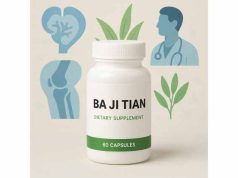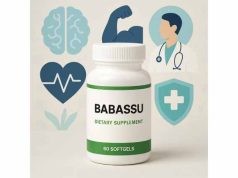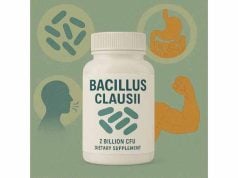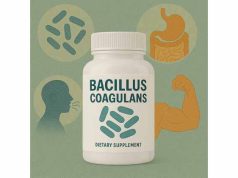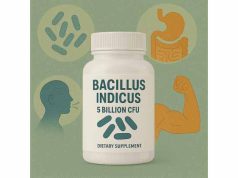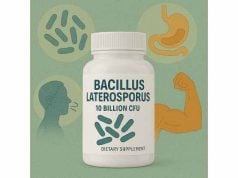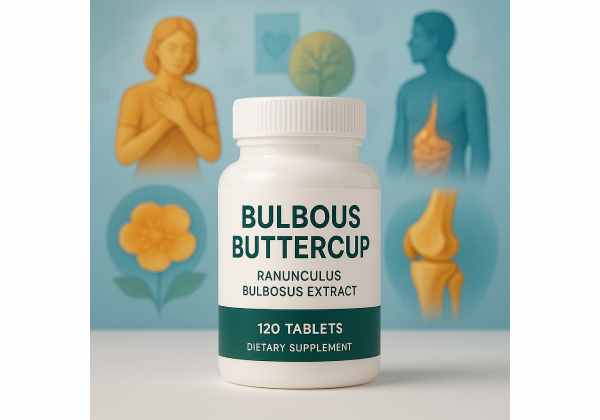
The bulbous buttercup (Ranunculus bulbosus) is more than just a wildflower dotting meadows with its golden blooms. For centuries, this resilient herb has played a subtle yet significant role in traditional herbal medicine across Europe and beyond. Today, renewed scientific interest surrounds bulbous buttercup’s unique phytochemical properties—especially its potential anti-inflammatory, analgesic, and skin-supportive effects. As a supplement, it intrigues health seekers searching for natural relief from minor aches, digestive imbalances, and even topical skin concerns. However, like many medicinal plants, proper understanding of its uses, safety, and limitations is crucial for safe and effective supplementation. This guide explores bulbous buttercup’s most important benefits, practical uses, and essential safety notes for today’s wellness consumers.
Key Takeaways
- Bulbous buttercup is traditionally valued for its anti-inflammatory, pain-relieving, and skin-soothing properties, but requires careful use due to its toxicity in raw form.
- It has been used in folk remedies for joint discomfort, mild digestive issues, and as an external poultice for skin irritations.
- Modern research points to several bioactive compounds in bulbous buttercup, but raw plant ingestion is not recommended due to potential toxicity.
- Most benefits come from carefully prepared extracts, tinctures, or homeopathic dilutions—not direct consumption of the raw plant.
- Consult a healthcare professional before using bulbous buttercup, especially if you are pregnant, breastfeeding, or on medications.
Table of Contents
- Bulbous Buttercup Overview: Traditional Uses and Modern Identity
- Biological Mechanisms and Scientific Insights into Bulbous Buttercup
- Evidence-Based Benefits and Popular Applications of Bulbous Buttercup
- Safety Precautions, Tolerability, and Side Effects of Bulbous Buttercup
- Effective Dosage, Best Ways to Use, and Administer Bulbous Buttercup
- Frequently Asked Questions About Bulbous Buttercup
Bulbous Buttercup Overview: Traditional Uses and Modern Identity
Bulbous buttercup, or Ranunculus bulbosus, is a perennial flowering herb native to Europe, now widespread across North America, Asia, and parts of Africa. Recognized by its glossy, bright yellow flowers and bulb-like base, the plant thrives in grassy meadows, pastures, and even disturbed soils. Although many see it as a common weed, its long history in traditional medicine suggests a more complex role.
Traditional Uses and Folklore
Historically, bulbous buttercup has been both revered and feared in folk medicine. Healers in Europe and Western Asia prized the plant for topical applications—primarily using poultices made from its leaves or flowers to ease joint discomfort, minor muscle aches, and certain skin conditions like sores and rashes. The juice was applied externally (never ingested raw) because it was known that eating fresh bulbous buttercup could cause nausea, vomiting, and irritation of the mouth and digestive tract.
Some cultures believed that the flower’s golden hue symbolized vitality and renewal. Shepherds and field laborers would sometimes use carefully prepared buttercup ointments for aching limbs after a long day’s work. In rural medicine, it became a remedy of necessity—available in the fields when little else was at hand.
From Folk Medicine to Homeopathy
In the 18th and 19th centuries, bulbous buttercup found new life in homeopathic preparations. Homeopaths began using highly diluted extracts, such as Ranunculus bulbosus tincture, claiming it relieved neuralgic pain, skin eruptions, and certain respiratory discomforts. While homeopathic remedies contain extremely low amounts of the active compounds (often far below pharmacological doses), they contributed to the continued use and study of this unique plant.
Modern Recognition and Supplement Use
Today, bulbous buttercup is rarely used in mainstream Western herbal medicine, but it persists in homeopathic pharmacies, some traditional herbal preparations, and experimental phytotherapy. Its extracts are sometimes featured in ointments for topical use, and occasionally in combination supplements targeting musculoskeletal or skin complaints.
With renewed interest in natural and “forgotten” remedies, researchers are beginning to study bulbous buttercup for its rich spectrum of phytochemicals—especially its potential anti-inflammatory, analgesic, and antimicrobial actions. Yet, the plant’s reputation for toxicity in its raw form has made careful extraction and standardized dosing a necessity.
Botanical Description and Identification
Botanically, bulbous buttercup is easy to spot. Its shiny yellow flowers (usually five petals) stand above deeply lobed leaves. The bulbous base, actually a swollen stem or corm, distinguishes it from related species. Flowering in late spring and early summer, it is both admired for its beauty and managed as a weed in pasturelands due to its potential toxicity to grazing animals.
Cultural Cautions and Modern Myths
Bulbous buttercup’s dual identity—as both folk remedy and pasture hazard—has created myths and misunderstandings. Some believe it is harmless because of its beauty, but improper use can lead to serious discomfort or even poisoning. Today’s best practices rely on careful extraction and knowledge of the plant’s chemistry, ensuring that any potential health benefits are balanced with safety.
By tracing the journey of bulbous buttercup from field to pharmacy shelf, we gain insight into its role in natural wellness—and why it remains both a symbol of resilience and a supplement to approach with care.
Biological Mechanisms and Scientific Insights into Bulbous Buttercup
To understand how bulbous buttercup works as a supplement or topical remedy, it is crucial to look beneath the surface—at the unique bioactive compounds it contains, and the biological mechanisms these compounds trigger in the body.
Key Phytochemicals: The Double-Edged Sword
The most notable active constituents of bulbous buttercup are a group of compounds known as ranunculin glycosides. When the plant is crushed or chewed, ranunculin is converted into protoanemonin, a volatile oil that is both highly irritant and—at carefully controlled doses—potentially therapeutic. Protoanemonin can cause blistering and inflammation on direct contact with skin or mucous membranes, which is why raw buttercup is never eaten and rarely used fresh in folk medicine.
Other key phytochemicals include:
- Flavonoids: Plant-based antioxidants believed to help reduce inflammation and oxidative stress.
- Saponins: Soap-like compounds with mild antimicrobial activity.
- Tannins: Astringent molecules that may tighten skin and reduce irritation.
Traditional Mechanisms of Action
In external applications, the irritant nature of protoanemonin was sometimes harnessed to increase blood flow to sore areas, stimulating the body’s healing response. This “counter-irritant” effect is similar to that of some classic herbal liniments, which create a warming or tingling sensation thought to distract from deeper pain or stiffness.
For digestive discomfort, folk practitioners sometimes used dried (not fresh) buttercup preparations in minute quantities, betting that the astringency of the plant could help tone the digestive tract. Such uses were always cautious, as even small overdoses of raw plant could cause gastrointestinal distress.
Modern Pharmacological Insights
Today’s scientists are investigating buttercup’s anti-inflammatory and analgesic effects in more detail. Early studies on isolated plant extracts have found that protoanemonin and related compounds may modulate inflammatory pathways, reduce local pain signals, and exhibit antimicrobial effects against some bacteria and fungi. The high flavonoid content may also protect cells from oxidative stress and promote tissue repair.
However, most of this research is still in laboratory or animal models, and the toxicity of the fresh plant remains a major limitation for direct supplementation. This is why nearly all modern products—whether tinctures, ointments, or homeopathic remedies—use either dried, heat-treated plant material (which deactivates protoanemonin) or extreme dilutions to avoid harm.
Preparation Determines Safety and Action
It’s vital to emphasize that preparation method drastically changes bulbous buttercup’s biological activity. Raw or freshly crushed plant is a potent irritant and potential toxin, while carefully dried or heat-treated extracts are considered much safer and may deliver the hoped-for therapeutic effects with minimal risk.
Homeopathic preparations (such as Ranunculus bulbosus 30C) are diluted far beyond pharmacological doses, aiming for energetic rather than direct chemical effects—a highly debated concept in mainstream science but still popular in some wellness circles.
Comparing Buttercup with Other Herbs
Unlike gentler herbs such as chamomile or calendula, bulbous buttercup occupies a unique niche—its strong irritant power can be both a liability and, when handled correctly, a therapeutic tool. This duality is mirrored in other “hot” or “stimulating” botanicals, but bulbous buttercup’s safety window is narrower, making expertise and quality control essential for its use.
As modern research continues, the focus remains on unlocking its anti-inflammatory and antimicrobial benefits while ensuring product safety and responsible dosing.
Evidence-Based Benefits and Popular Applications of Bulbous Buttercup
Despite its humble appearance, bulbous buttercup offers a surprising range of wellness applications when prepared and used with care. While its raw form is never ingested due to toxicity, standardized extracts, topical ointments, and homeopathic dilutions are utilized for targeted purposes. Here’s what current evidence and tradition reveal about the real-world benefits of this storied herb.
1. Natural Relief for Minor Aches and Joint Discomfort
One of the most consistent uses for bulbous buttercup, historically and today, is topical relief for aching joints, mild rheumatism, or muscular soreness. The plant’s irritating compounds, when neutralized by drying or heating, can gently stimulate blood flow to the affected area, promoting warmth and a sense of relaxation. Ointments containing bulbous buttercup extract are sometimes applied to areas of minor stiffness, with users reporting reduced discomfort after repeated use.
2. Soothing Topical Remedy for Skin Irritations
Bulbous buttercup’s astringent and antimicrobial properties make it a candidate for managing certain skin conditions. Carefully prepared ointments or salves are used externally for minor sores, superficial wounds, or non-severe rashes. Folk medicine sometimes applied buttercup compresses to insect bites or rough skin, believing it helped calm redness and swelling. It’s important, however, to avoid using the raw plant on broken skin, as this may cause blistering.
3. Digestive Tonic in Traditional Herbalism
In the past, dried bulbous buttercup was included in very small amounts in herbal blends for digestive sluggishness or mild cramps. Some practitioners believed its bitterness could stimulate appetite or relieve gas. Today, these uses are rare and only attempted by trained herbalists, due to the plant’s narrow margin of safety and potential for GI upset if improperly dosed.
4. Use in Homeopathy for Nerve and Chest Discomfort
Homeopathic medicine utilizes highly diluted extracts of Ranunculus bulbosus for complaints such as sharp, shooting neuralgic pain, superficial chest discomfort, and certain types of skin eruptions. While these products contain negligible amounts of the original plant and are considered safe for most people, scientific support for their efficacy remains controversial.
5. Potential Anti-Inflammatory and Antimicrobial Actions
Modern studies exploring bulbous buttercup extracts have highlighted the plant’s flavonoids and saponins as potential modulators of inflammation. In vitro research suggests certain extracts may slow bacterial growth or reduce inflammatory signaling, which may explain the plant’s historical reputation for wound and joint care. While promising, these results require further clinical validation.
6. Psychological and Energetic Uses
In some holistic traditions, bulbous buttercup is thought to “brighten” the mood and support emotional resilience, echoing the flower’s cheerful presence in the landscape. These effects, while mainly anecdotal, add to the plant’s mystique in wellness circles.
Important Limitations and Realistic Expectations
It’s vital to remember that all reported benefits of bulbous buttercup depend on the form and quality of the preparation. Raw plant use is always discouraged. Most positive outcomes are reported with topical ointments, carefully prepared tinctures, or homeopathic formulas, not direct ingestion. If you are seeking targeted relief—especially for musculoskeletal or minor skin issues—look for products from reputable brands that follow modern safety guidelines.
Integrative Wellness Role
Bulbous buttercup is best viewed as one piece of a larger holistic health approach. It may offer gentle support for comfort and skin wellness when used as directed but should never replace evidence-based medical care for serious conditions. Always pair supplementation with healthy lifestyle choices, and consult knowledgeable practitioners for guidance.
Safety Precautions, Tolerability, and Side Effects of Bulbous Buttercup
Bulbous buttercup stands out in the herbal world for its dual nature—offering both potential benefits and clear risks if misused. Its reputation as a pasture weed with toxic properties is well-earned, and safety must always be the top priority for anyone considering bulbous buttercup supplements or remedies. Here’s what you must know to make informed, responsible decisions.
Recognizing Toxicity and Safe Usage
The most critical safety message is this: never ingest or apply raw, fresh bulbous buttercup to your skin or mucous membranes. The living plant contains protoanemonin, a powerful irritant that can cause blistering, burns, and severe digestive upset if swallowed. Poisoning from fresh bulbous buttercup is rare in humans due to its unpleasant taste but can happen, especially with homemade or experimental remedies. Symptoms of ingestion may include:
- Severe mouth and throat irritation
- Excessive salivation
- Stomach pain, nausea, vomiting, and diarrhea
- Dizziness or faintness in rare cases
Direct skin contact with the fresh plant may cause:
- Redness and burning
- Blistering or ulceration
- Persistent itching
Most reported cases of poisoning involve grazing animals, as bulbous buttercup is commonly found in pastures, but human incidents are still possible—especially among children or foragers unfamiliar with the plant.
How Safe Preparations Are Made
To be safely used in supplements or topical products, bulbous buttercup must undergo processing steps that neutralize protoanemonin. These steps typically include:
- Drying: Air drying or gentle heat treatment converts protoanemonin into anemonin, a less toxic compound.
- Dilution: Homeopathic preparations use extreme dilution, containing negligible amounts of the original compound.
- Extraction: Commercial ointments or tinctures use controlled extraction and filtration methods to standardize active ingredients and ensure safety.
Side Effects and Allergic Reactions
Even after processing, some individuals may be sensitive to buttercup extracts. Potential side effects—though much less common in commercial products—can include:
- Mild skin irritation, especially if you have sensitive skin or allergies
- Rare allergic reactions such as rash, itching, or swelling
- Temporary digestive upset if taken internally (only in properly prepared extracts or tinctures)
If any sign of allergy or irritation occurs, discontinue use immediately and wash the affected area with cool water. Seek medical advice if symptoms persist.
Who Should Avoid Bulbous Buttercup?
Certain groups are at higher risk for adverse reactions and should avoid bulbous buttercup unless under the supervision of a qualified herbalist or healthcare provider:
- Pregnant or breastfeeding women (insufficient safety data)
- Young children
- People with known allergies to buttercup or related plants (family Ranunculaceae)
- Individuals with a history of eczema or chronic skin sensitivities
- Anyone taking prescription medications for chronic illness without medical guidance
Potential Drug and Supplement Interactions
While there are no well-documented interactions between processed bulbous buttercup and common medications, the lack of robust clinical data means caution is warranted. Avoid combining buttercup products with other strong irritants or skin-sensitizing agents, and do not use on open wounds or severe burns.
Sourcing and Product Quality
Quality is essential when using any buttercup-based supplement or ointment. Only purchase from established companies that follow good manufacturing practices, list all ingredients, and provide clear usage directions. Avoid DIY preparations unless you have expert botanical knowledge and access to reliable, safe processing techniques.
Emergency Response
If you or someone else accidentally ingests fresh bulbous buttercup or experiences a severe reaction, seek medical help immediately. Bring a sample of the plant or product, if possible, to aid in diagnosis and treatment.
Summary: Best Practices for Safety
- Never use the raw plant internally or externally.
- Choose products made from dried, processed, or highly diluted extracts.
- Patch test topicals on a small skin area before broader use.
- Keep all bulbous buttercup products away from children and pets.
- Consult a healthcare provider before combining with medication or if you have a chronic condition.
By respecting the power and limitations of bulbous buttercup, you can reduce risks and better enjoy its carefully harnessed benefits.
Effective Dosage, Best Ways to Use, and Administer Bulbous Buttercup
Determining how to safely and effectively use bulbous buttercup hinges on the form and purpose of the preparation. Unlike milder herbs, this is not a plant for casual home remedies, and the raw plant should never be eaten or applied directly. The most common and safest options are carefully processed tinctures, homeopathic dilutions, and standardized ointments.
Topical Use: Ointments and Salves
The main modern use of bulbous buttercup is as a topical ointment or salve for minor joint aches, stiffness, or mild skin irritations. Key guidelines include:
- Always use commercially prepared products or those made by a trained herbalist.
- Apply a thin layer to unbroken skin; avoid open wounds or sensitive areas.
- Test on a small area first to check for irritation.
- Use 1–2 times daily, following label instructions.
Homeopathic Preparations
Homeopathy uses Ranunculus bulbosus in highly diluted tinctures or pellets, often at potencies such as 6C or 30C. These are considered safe for most people (due to extreme dilution), but efficacy is debated in the scientific community. Standard practice is:
- Follow package directions; typical dose is 3–5 pellets under the tongue, up to 3 times daily.
- Use only for short-term symptom relief unless directed by a practitioner.
Internal Use: Tinctures and Extracts
Rarely, some traditional herbalists use alcohol-based tinctures from dried bulbous buttercup. Safe internal use demands strict caution:
- Only use tinctures made from dried (not fresh) bulbous buttercup.
- Usual dose is very small—often 1–2 drops diluted in water, once or twice daily.
- Do not exceed recommended doses; increase only under supervision.
- Never use during pregnancy, while breastfeeding, or for children.
Timing and Duration
- For acute topical relief, use for a few days until symptoms improve.
- For chronic concerns, consult an herbalist or practitioner for guidance.
- Discontinue at the first sign of irritation or allergy.
Who Should Use Bulbous Buttercup?
- Adults seeking natural options for mild joint discomfort or minor skin issues
- Individuals working with trained herbalists or homeopaths
Who Should Avoid It?
- Anyone seeking self-treatment for serious or undiagnosed health issues
- Pregnant or nursing women, children, and those with chronic illnesses, unless under medical care
Product Selection Tips
- Look for third-party tested brands with transparent labeling.
- Check for batch numbers, expiration dates, and clear usage instructions.
- Avoid multi-herb blends unless you understand every ingredient.
Storage and Shelf Life
- Store ointments and tinctures in a cool, dark place.
- Discard if the product changes color, odor, or consistency.
Combining with Other Supplements
- Can be used alongside gentle herbs like calendula or arnica for topical support, but avoid mixing with other strong irritants or unknown plants.
Practical Self-Care Advice
- Never experiment with foraged bulbous buttercup unless you have advanced botanical training.
- If you have sensitive skin, consider patch-testing any new product.
In summary, safe and effective use of bulbous buttercup always depends on correct form, proper dosing, and respect for its potent chemistry.
Frequently Asked Questions About Bulbous Buttercup
What is bulbous buttercup and is it safe as a supplement?
Bulbous buttercup is a wildflower known for its traditional topical uses in herbal medicine. Only dried, processed, or highly diluted forms are safe as supplements—never the raw plant, which is toxic if ingested or applied directly.
Can bulbous buttercup help with joint pain or arthritis?
Some ointments and extracts made from processed bulbous buttercup are used for minor joint aches or muscle discomfort. Never use the raw plant. Always follow dosage guidelines and consult a professional for chronic pain conditions.
Are there any side effects from using bulbous buttercup ointment?
Processed ointments can rarely cause mild skin irritation or allergies. Always patch-test before broad use, avoid broken skin, and discontinue use at the first sign of reaction. Never use raw buttercup on the skin.
Is it safe to take bulbous buttercup internally for digestion?
Internal use is rare and only safe with products made from dried bulbous buttercup, under expert supervision. Do not self-dose or use home-prepared remedies. Seek advice from an experienced herbalist.
How do I identify bulbous buttercup in the wild?
Look for shiny yellow flowers, deeply lobed leaves, and a distinctive bulb-like base. However, wild harvesting for self-medication is not recommended due to toxicity risks and possible confusion with other buttercup species.
Can children or pregnant women use bulbous buttercup?
No. Due to insufficient safety data and the plant’s toxicity, bulbous buttercup should not be used by pregnant or breastfeeding women, infants, or young children.
Where can I buy safe bulbous buttercup supplements or ointments?
Purchase only from reputable herbal suppliers or homeopathic pharmacies. Products should be clearly labeled, batch-tested, and accompanied by usage instructions. Avoid untested, homemade, or foraged preparations.
Disclaimer:
The information presented in this article is for educational purposes only and is not intended as a substitute for professional medical advice, diagnosis, or treatment. Always consult a qualified healthcare professional before starting any new supplement or herbal remedy, especially if you have a medical condition, are pregnant, nursing, or are taking medications.
If you found this guide helpful, please consider sharing it with friends or on your favorite social platforms, such as Facebook or X (formerly Twitter). Your support helps us provide more trusted, science-based wellness information—thank you for reading and following along!

